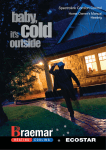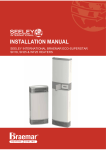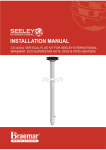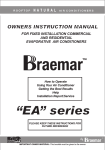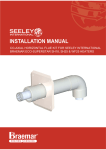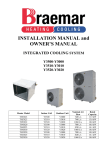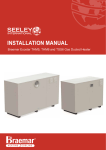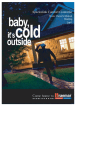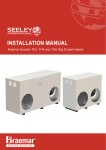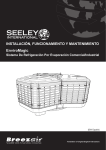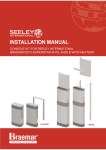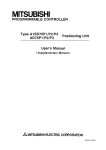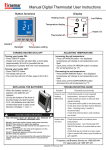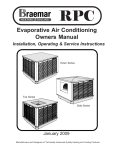Download INSTALLATION MANUAL
Transcript
INSTALLATION MANUAL Braemar Ecostar THD3/THMD5 Gas Ducted Heater THIS HEATER IS TO BE INSTALLED BY AN AUTHORISED PERSON ONLY ALWAYS read the operating instructions before operating the appliance. DO NOT place articles on or against this appliance. DO NOT use or store flammable materials near this appliance. DO NOT spray aerosols in the vicinity of this appliance while it is in operation. DO NOT operate this appliance with panels, covers or guards removed. This Braemar gas ducted heater must be installed in accordance with these instructions, local gas fitting regulations, municipal building codes, electrical wiring regulations, Australian Standard AS/NZS 5601 Gas Installations and any other relevant statutory requirements. This heater must not be installed downstream from an evaporative cooler, air washer or indoor unit of a refrigerated system. This heater is not suitable for installation in a marine environment. Gas Type: Gas Consumption: Refer label alongside gas inlet. Refer data label on underside of appliance lid. UNPACKING THE HEATER Remove the plastic wrap and cardboard transport cover. Check that the heater model and gas type are as required model details are provided on the specification label on the end panel of the heater, gas type is given on the label next to the gas inlet. Report any transit damage within 7 days - do not install the heater if it is damaged. Dimension (mm) Heater Model THD315/THD320 THMD516/THMD520 THD330 THMD530 A B C D E F G H J K L M N P Q R S T U V W 385 635 550 25 35 55 770 55 600 330 530 565 530 330 340 340 350 745 365 395 770 510 650 540 25 35 90 880 80 600 330 545 680 545 450 345 405 475 925 530 565 950 G D B A M F K H C N ELECTRICAL ENTRY FLUE CONNECTION J L E GAS CONNECTION OUTLET/ SUPPLY AIR INLET/ RETURN Q R U T P OUTLET/ SUPPLY AIR INLET/ RETURN Supply/return air plenum NOT SUPPLIED WITH BRAEMAR HEATER S Bottom View W V MINIMUM FLUE CLEARANCES 75mm From a drain pipe or soil pipe. 300mm From any other flue terminal, cowl, or combustion air intake. Below eaves, balconies, and other projections. Horizontally from an openable window, door, non-mechanical air inlet, or any other opening into a building with the exception of sub-floor ventilation. 500mm 1 From electricity meter or fuse box. From a return wall or external corner. Horizontally from any building structure or obstruction facing a terminal. THD3, THMD5 1000mm From a gas meter. From a mechanical air inlet, including a spa blower. Vertically below an openable window, on-mechanical air inlet, or any other opening into a building with the exception of sub-floor ventilation. 1500mm Horizontally in the direction of discharge from an openable window, door, non-mechanical air inlet, or any other opening into a building with the exception of sub-floor ventilation. Refer also: AS/NZS 5601 Gas Installations ELECTRICAL CONNECTION Electrical wiring & fittings must be installed by a licensed Electrician. Seeley International recommends that all Braemar gas ducted heaters are wired with a dedicated circuit from the distribution board with a separate circuit breaker. Wiring must be installed in accordance with the relevant electrical standards & regulations. The electrical supply must be 240V 50Hz. IMPORTANT A suitable 10A 3-pin 240V GPO must be fitted adjacent to the heater. ENSURE THAT POLARITY OF Ensure that the polarity of the power supply is correct. POWER SUPPLY IS CORRECT GAS CONNECTION All gas supply piping must be installed by a licensed gas fitter in accordance with Standard AS/NZS 5601 Gas Installations. Gas connection point: All models - 3/4" BSP female flare nut. Gas supply piping must be sized to ensure a minimum gas pressure of 1.13 kPa for natural gas appliances or 2.75kPa for propane appliances at the inlet to the heater with the heater and all other gas appliances operating at maximum gas rate. Detailed pipe sizing information is contained in Standard AS/NZS 5601 Gas Installations. The maximum gas rate for the heater is located on the specification label on the underside of the heater lid. An AGA approved gas cock/manual shut-off valve must be fitted in the gas supply line adjacent to the heater (outside the heater cabinet) to enable isolation of the heater for maintenance and/or servicing. Ensure that all air is purged from gas line. Ensure that there are no gas leaks. Gas Connection All Models GAS INLET PIPE Remove gas inlet pipe from inside the heater. Fit grommet supplied, to gas inlet pipe transport hole. Gas inlet pipe transport hole HEATER INSTALLATION Remove old heater from supply/return air plenum and discard. Check supply/return air plenum structural integrity. If plenum is damaged the plenum will need to be removed and a TH or THM ducted heater will need to be installed. Pilot hole for thermistor bracket required on supply/outlet side only. Installer to check which side is supply/outlet air. Pilot hole Installing thermistor preperation (THMD5 ONLY) Thermistor location is CRITICAL to the correct operation of the heater. Supply air direction Pilot hole Drill 2.5mm pilot hole in the centre of plenum supply 30mm air cutout 30mm from inside face. Attaching heater to supply/return air plenum Supply/return air plenum Place strip of adhesive foam tape supplied in heater along top of supply/return air plenum centre panel. Lower heater onto supply/return air plenum. ENSURE FAN END OF HEATER IS LOCATED OVER RETURN AIR SIDE OF PLENUM. Centre panel Adhesive foam tape Supply/return air plenum NOT SUPPLIED WITH BRAEMAR HEATER SEELEY INTERNATIONAL – INSTALLATION MANUAL 2 Installing Thermistor (THMD5 ONLY) Thermistor location is CRITICAL to the correct operation of the heater Overtemp bracket Remove heat exchanger end panel and heat shield. Carefully detach the bundled thermistor cable from the overtemp bracket. Feed thermistor cable and bracket down to supply/return air plenum base panel. Secure thermistor bracket using screw provided into previously drilled pilot hole with long fold towards supply air cutout. Bundled thermistor cable Plenum supply air cutout Flue connection THD3 - Powder coated die cast flue terminal THMD5 - Powder coated metal flue terminal Attach powder coated die cast flue terminal to heater Attach flue connection spigot to heater over flue outlet over flue outlet, fixing in place using screws supplied with heater. A flue guard kit is available P\No 079073 using screws supplied with heater. Attach powder coated metal flue terminal to flue connection spigot, fixing in place using screw supplied with heater. A flue guard kit is available P\No 079073 THMD5 When reversing the flue outlet the flue outlet panel must be relocated to the other side of heater to ensure the combustion air inlet louvres are on the same side as the flue terminal. THD3 FLUE THMD5 FLUE Flue outlet panel Flue connection spigot External powder coated die cast flue terminal (THD3) External powder coated metal flue terminal (THMD5) Fix in place with screw 3 THD3, THMD5 THERMOSTAT LOCATION SCC connection THD3 THD3 - 2-wire thermostat or Braemar SCC The SCC is connected directly to the BSC. THMD5 - SCC (to achieve 5.2 star rating) The wall control should be located central to the main living area approximately 1.5m above floor level. The main living area should be confirmed with the occupants. AUTO ON HEAT WED Wall control placement is critical to ensure correct functioning of the heating system. The following points must be taken into account: HOME ZONE 1 2 3 4 ON/OFF HOME/AWAY Avoid direct sunlight. Avoid mounting on external walls. Avoid mounting near heat sources such as stoves, TV sets etc. Do not locate in the air stream from an outlet register. Do not locate in draughty areas. Do not locate in hallways. Do not locate adjacent to return air grille. Always fill cable entry hole in wall. 24V "manual" digital thermostat (THD3 ONLY) THD series heaters can all be used with a standard 2-wire type manual digital thermostat. Connect a low voltage 2-wire loom between the thermostat and "T/STAT" on the BSC circuit board. Note that with Braemar THD3 series heaters zoning and evaporative or refrigerated cooler operation is not possible with these thermostats. BSC COMMISSIONING THD3 - INSTALLER OR COMMISSIONING AGENT Installation checks Check for gas leaks - rectify any leaks found. Check that the flue system is connected, sealed and installed with appropriate clearances. Check that thermostat is wired correctly and installed in a suitable location. Check that the heater is level in both directions Gas pressure checks Connect a manometer to the outlet pressure test point on the gas valve. Start the heater. THD3 Braemar Spectrolink Comfort Control (SCC) Run heater and check pressure at outlet test point, adjust if necessary: - All natural gas models: 875 +/- 50 Pa - Propane models: - THD3/15/20 2500 +/- 200 Pa - THD330 1900 +/- 200 Pa OUTLET PRESSURE TEST POINT A 20m loom is supplied with the heater for connnection directly between the heater and the SCC. Feed the wiring loom through the large hole in the SCC mounting bracket and attach the mounting bracket to the wall. Plug the wiring loom into the socket on the SCC and carefully slide the SCC into the mounting bracket. REGULATOR ADJUSTMENT COVER Gas Out SCC connection THMD5 The SCC is connected directly to the MCB (note that this is different to Braemar TH heaters where the SCC is connected to the BSC). HOME for 5-10 minutes to reach operating temperature. trimpot located on the BSC board (alongside the 10 pin connector). Fully clockwise = fan speed 10 Fully anti-clockwise (3/4 turn) = fan speed 7 AUTO ON WED Turn the heater on at the thermostat and allow to run Check the air flow from all outlets. If required, adjust the fan speed by turning the MCB HEAT Set maximum fan speed ZONE 1 2 3 4 INCREASE FAN SPEED ON/OFF HOME/AWAY DECREASE BSC SEELEY INTERNATIONAL – INSTALLATION MANUAL 4 COMMISSIONING THMD5- INSTALLER OR COMMISSIONING AGENT Installation checks Check for gas leaks - rectify any leaks found. Check that the flue system is connected, sealed and SYSTEM SETUP Note that the settings below can only be adjusted within the first hour of powering the SCC. After that, disconnect the SCC loom, discharge the SCC capacitor then re-connect the loom. Gas pressure checks Set the time & day (SCC thermostat) With the SCC in OFF mode, press and hold SET Use the UP/DOWN arrows to adjust the time, press SET when satisfied Use the UP/DOWN arrows to adjust the day, press SET when satisfied Connect manometer to outlet pressure test point on Set the heater & cooler type (SCC thermostat) installed with appropriate clearances. Check that thermostat is wired correctly and installed in a suitable location. Check that the heater is level in both directions. gas valve. Start heater as described in Owner’s Manual. Wait 30 seconds after heater lights to ensure heater has reached high gas rate. With the SCC in OFF mode, press SET & AC MODE simultaneously. THD3 use the UP/DOWN arrows to adjust the heater High gas pressure: - Natural Gas Nominal 875 Pa (825 to 925 Pa) - Propane Nominal 2250 Pa (2050 to 2450 Pa) Adjust only if outside this range USE LARGE HIGH GAS ADJUSTMENT SCREW hold small adjustment screw still type to HEAT 3 (factory default), press SET when satisfied THMD5 use the UP/DOWN arrows to adjust the heater type to HEAT 4, press SET when satisfied Use the UP/DOWN arrows to adjust the cooler type, press SET when satisfied COOL 1 = evaporative (factory default) COOL 2 = refrigerated (THMD5 only) Check low gas Set maximum fan speed (THMD5 ONLY) Check high gas Remove one lead from modulating coil (LOW VOLTAGE, 0-17 Vdc) Low gas pressure: - Natural Gas Nominal 100 Pa (90 to 110 Pa) - Propane Nominal 180 Pa (170 to 190 Pa) Adjust only if outside this range USE SMALL LOW GAS ADJUSTMENT SCREW hold large adjustment screw still Re-check high gas Re-connect lead to modulating coil High gas pressure: - Natural Gas Nominal 875 Pa (825 to 925 Pa) - Propane Nominal 2250 Pa (2050 to 2450 Pa) Adjust only if outside this range USE LARGE HIGH GAS ADJUSTMENT SCREW hold small adjustment screw still Press and hold SET and press FAN Check the air flow from all outlets If required, adjust the fan speed (7, 8, 9 or 10) using the UP/DOWN arrows. Press SETwhen satisfied. Balance the air flows With the heater running and all outlets open, adjust balancing dampers to achieve a suitable air flow from each outlet. Programming the thermostat (SCC thermostat) Discuss auto program requirements with the customer To enter programming mode press and hold SET with the SCC in AUTO mode Use the UP/DOWN arrows to adjust the day or group THMD5 Low gas adjustment screw Modulating coil leads High gas adjustment screw ENSURE BOTH LEADS ARE CONNECTED TO MODULATING COIL WHEN FINISHED of days to be programmed then press SET - system goes to WAKE time period Adjust time, temperature, zones and fan speeds: Use UP/DOWN arrows to adjust start time then press SET Use UP/DOWN arrows to adjust required temperature then press SET System will go to next time period Repeat setting procedure for AWAY, HOME and SLEEP time periods Explain system operation to customer Explain the operation of the system to the customer/home owner. Outlet pressure test point 5 Hand the operating instructions and warranty card to the customer/home owner. THD3, THMD5 TROUBLE SHOOTING & DIAGNOSTICS DIAGNOSTIC CODES THD3 SCC thermostat required (refer service manual for full instructions) Code No Shut down type Description 1 P-100 closed at start 2 P-100 failed to close 3 P-100 open during run 7 Ignition failure 9 Internal memory failure If the heater fails to start, try the following: SCC display L1 Reset, 1 L1 Reset, 2 SSD Normal L1 Reset, 7 L2 Reset, 9 10 HX OT1 opened SSD/L1 Normal 11 EFS shutdown SSD/L1 19 HX OT2 open at start Normal L2 Reset, 19 DIAGNOSTIC CODES THMD5 SCC thermostat required (refer service manual for full instructions) Code Description No 1 P-25/50 closed at start * * * Shut down type L1 SCC display Reset, 1 2 P-25/50 failed to close 3 P-25/50 open during run SSD Normal 4 Thermistor > 70oC during run SSD Normal 5 Thermistor not connected or short circuit L1 Reset, 5 7 Ignition failure L1 Reset, 7 9 Internal memory failure L2 Reset, 9 L1 Reset, 2 10 HX OT1 opened SSD/L1 Normal 11 EFS shutdown SSD/L1 Normal 12 P-75/100 closed at start L1 Reset, 12 13 P-75/100 failed to close L1 Reset, 13 14 P-75/100 open > 30 sec during run SSD Normal 15 Thermistor in cool location in duct SSD Normal 16 Thermistor not installed in outlet duct 19 HX OT2 open at start 1ST DC16 2ND DC16 L2 L1 L2 Reset, 16 Reset, 16 Reset, 19 * Shut down type dependent on current operating status. SSD Safety shut down: Reset not required. L1 Lockout 1: User reset from SCC (press RESET twice), or Manual t/stat off-on-off-on wait 5 seconds at each state, or Power off - power on. L2 Lockout 2: Reset from SCC service mode only MODULATING CIRCUIT BOARD (MCB) LED INDICATORS THMD5 Status Power on Heater off 100% gas LED 1 GREEN LED 2 RED LED 3 RED LED 4 RED LED 5 RED On Off Off Off Off On On On On On 75% gas On On On On Off 50% gas On On On Off Off 25% gas On On Off Off Off On Off Off Off Flash 1s on/1s off Off Off Flash 1s on/1s off Off P-100% closed at start P-75% closed at start P-25/50% closed at start P-100% failed to close P-75% failed to close P-25/50% failed to close P-100% open during run P-75% open during run P-25/50% open during run Invalid dipswitch setting On On On On On Flash Flash 1s on/1s off 1s on/1s off Off Off Off Off Off Off Flash 2s on/2s off Off Flash 2s on/2s off Off Flash Flash 2s on/2s off 2s on/2s off Off Off On On On On Flash 1s on/1s off On On On Flash 1s on/1s off Off Off Off Off Off On On Flash Flash Flash Flash 1s on/1s off 1s on/1s off 1s on/1s off 1s on/1s off Heater model SW 1 SW 2 SW 3 OFF OFF OFF ON OFF OFF ON OFF OFF OFF ON ON OFF OFF ON ON OFF ON Heaters are THMD516N supplied pre-set to the following THMD520N dipswitch THMD530N settings THMD520LPG THMD530LPG ON ON SW 4 No power. Is green LED on BSC circuit board on? Plug in heater supply lead Turn on power Turn on circuit breaker No gas supply. Min' supply pressure - 1.13 kPa (NG) - 2.75 kPa (LPG) Has gas meter been installed? Turn gas on at gas meter Thermostat not connected Connect "manual/2-wire" thermostat to "MAN T/STAT" terminals on circuit board Connect Braemar Spectrolink CC to "CC" terminals on circuit board No thermostat communication. Check for "YES" on SCC display when first powered Thermostat not calling for heat Adjust set point above current room temperature. Check LED's - centre LED (red) on steady Combustion fan does not start Check that the fan is not blocked or jammed No spark Check flue cowl is installed correctly Check wiring to pressure switch is not dislodged Spark but no ignition Check gas valve on/off switch is set to ON Check flame roll-out switch is closed (press red button) Room fan does not start Check room fan wiring connected correctly All checks OK but still does not start Disconnect power, wait 5 minutes and start again If the heater still does not start or operate correctly after running through these troubleshooting and diagnostic checks contact: WARRANTY SERVICE: 1300 650 644 TECHNICAL SUPPORT: 1300 650 399 Please have your appliance model number, serial number, and any displayed fault codes available prior to calling. Example THMD520N ON 1 2 3 4 SEELEY INTERNATIONAL – INSTALLATION MANUAL 6 SAFETY INSTRUCTIONS Employers and Employees Responsibility Some points to consider The installation and maintenance of gas ducted heating units, particularly at height, has the potential to create Occupational Health and Safety issues for those involved. Installers are advised to ensure they are familiar with relevant State and Federal legislation, such as Acts, Regulations, approved Codes of Practice and Australian Standards, which offer practical guidance on these health and safety issues. Compliance with these regulations will require appropriate work practices, equipment, training and qualification of workers. Seeley International provides the following information as a guide to contractors and employees to assist in minimising risk. Some points to consider when working on or in a roof What is the best and safest access to the roof and working areas? What condition is the roof in? Should the roof structure and surface be checked? Does the worker have appropriate footwear? Are all power cables/extension leads safe and appropriately rated? Are all ladders, tools and equipment suitable and in good condition? Where ladders are to be used, is there a firm, stable base for them to stand on? Can they be tied or secured in some way at the top? Is there a roof anchor to attach a harness and lanyard to? If so, instruction should be issued for the use of an approved harness or only suitably trained people used. Are all tools and materials being used, prevented from slipping and falling onto a person at ground level? Is the area below the work area suitably protected to prevent people entering this area? Does the work schedule take into account weather conditions, allowing for work to be suspended in high winds, thunder storms/lightning or other types of weather giving wet, slippery surfaces? Is there an on-going safety check system of harnesses, ropes, ladders and access/lifting equipment, and any anchor points on roofs before the commencement of work? Is there a system which prevents employees from working on or in roofs if they are unwell or under the influence of drugs or alcohol? Are there any special conditions to consider i.e. excessive roof pitch, limited ground area, fragile roof, electrical power lines? Risk Assessment A risk assessment of all hazardous tasks is required under legislation. A risk assessment is an essential element that should be conducted before the commencement of work, to identify and eliminate the risk of falls and other risks, or to minimise these risks by implementing control measures. This does not need to be a complicated process - it is a matter of assessing the job to be done and considering what actions are necessary so the person doing the job does not injure themselves. This should be considered in terms of: What are the chances of an incident occurring? What could the possible consequences be? What can be done to reduce, or better still, eliminate the risk? Warranty Service Australia 1-300-650-644 seeleyinternational.com It is the policy of Seeley International to introduce continual product improvement. Accordingly, specifications are subject to change without notice. Please consult with your dealer to confirm the specifications of the model selected. 641836c www.braemar.com.au








